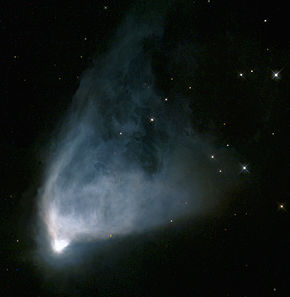NGC 2261
Appearance
| Reflection nebula | |
|---|---|
 | |
| Observation data: J2000.0 epoch | |
| Subtype | variable nebula |
| Right ascension | 6h 39m 10s[1] |
| Declination | +8° 45′[1] |
| Distance | 2,500 ly |
| Apparent magnitude (V) | 9.0 |
| Apparent dimensions (V) | 2′ |
| Constellation | Monoceros |
| Designations | Hubble's Variable Nebula,[1] Caldwell 46 |
NGC 2261 (also known as Hubble's Variable Nebula or Caldwell 46) is a variable nebula located in the constellation Monoceros. The nebula is illuminated by the star R Monocerotis (R Mon), which is not directly visible itself.
NGC 2261 was imaged as Palomar Observatory's Hale Telescope's first light by Edwin Hubble on January 26, 1949,[2] some 20 years after the Palomar Observatory project began in 1928. Hubble had studied the nebula previously at Yerkes and Mt. Wilson.[2]
One explanation proposed for the variability is that dense clouds of dust near R Mon periodically block the illumination from the star.[3]
See also
References
- ^ a b c "SIMBAD Astronomical Database". Results for NGC 2261. Retrieved 2007-04-11.
- ^ a b http://365daysofastronomy.org/2009/01/26/january-26-60th-anniversary-of-hale-telescope-first-light/
- ^ "A model for the cometary nebula NGC 2261". SAO/NASA ADS Astronomy Abstract Service. Retrieved 2010-11-28.
External links
Wikimedia Commons has media related to NGC 2261.
- European Homepage for the HST – Hubble photos and information on NGC 2261
- wikispaces.com – Images by amateur astronomers
- NGC 2261 on WikiSky: DSS2, SDSS, GALEX, IRAS, Hydrogen α, X-Ray, Astrophoto, Sky Map, Articles and images
